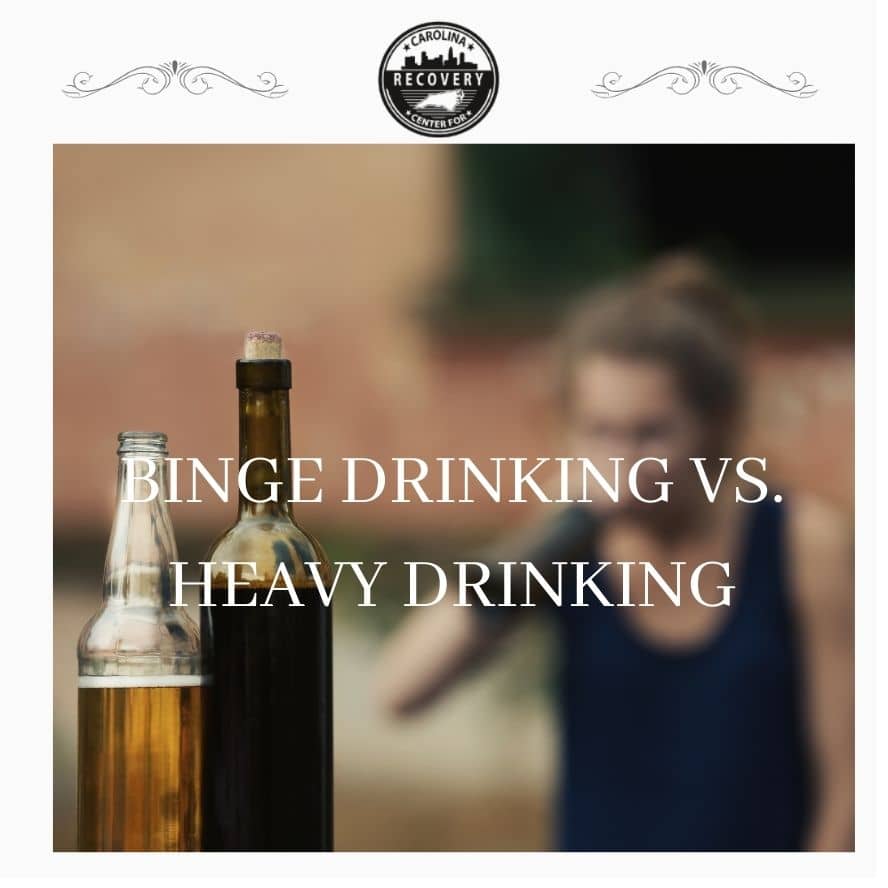Binge Drinking vs. Heavy Drinking: What is the Difference?

Medically Verified: 2/1/24
Medical Reviewer
Chief Editor

All of the information on this page has been reviewed and verified by a certified addiction professional.
Most American adults consume alcohol occasionally, and many regularly consume alcoholic beverages. For many, drinking alcoholic beverages is an enjoyable part of their social life. They may regularly enjoy a drink with friends after work, a beer at a game, or a glass of wine with dinner.
For others, drinking becomes problematic. Some people may use alcohol to dull uncomfortable emotions, manage stress, or overcome social anxiety. While many people drink excessively from time to time without long-term effects, some develop alcohol addiction.
Many terms describe excessive alcohol consumption, including binge drinking and heavy drinking. They may sound the same, but are they?
It is essential to understand the differences between binge drinking and heavy drinking and recognize the signs of both forms of excessive alcohol consumption so you can identify and address alcohol abuse.
Alcohol abuse affects every aspect of a person’s life, from their health and relationships to how they age. Very few parts of a person’s life escape the reach of alcohol abuse. Their mental, physical, and social health can suffer if their drinking continues.
To put binge drinking or heavy drinking behind you, you must get the treatment and support you need to overcome your problematic drinking. The first step is knowing the difference between these two forms of excessive alcohol consumption.
How Much is Too Much?
According to the Centers for Disease Control (CDC), moderate drinking can be part of a healthy lifestyle. Drinking in moderation is unlikely to cause harm to a person’s physical or mental health.
So, what is moderation? The CDC defines moderate drinking as one drink per day for women and two for men.[1] A drink is defined as:
- 12 ounces of beer
- 5 ounces of wine
- 1.5 ounces of distilled spirits, such as whisky, rum, or vodka
It can be challenging to keep track of your alcohol consumption when you’re out at a party or social event. You can quickly drink more than the CDC has determined to be safe. If you have a beer or two during the day while watching a game, a glass of wine at dinner, and a cocktail afterward, you would be consuming much more alcohol than the CDC recommends.
But would this be an example of binge or heavy drinking? It’s essential to understand the difference.
Binge Drinking vs. Heavy Drinking
Problematic, excessive alcohol consumption can lead to serious health complications, legal trouble, and loss of jobs and relationships. Binge drinking and heavy drinking are examples of problematic drinking that can lead to alcohol dependence without intervention or treatment.
What is Binge Drinking?
Binge drinking is a pattern of excessive drinking that often results in a person having a blood alcohol content (BAC) of 0.08%. The CDC defines a binge as four or more drinks in a single occasion for women and five or more for men.[2] Drinking a large amount of alcohol in a short time generally leads to intoxication, putting people at increased risk of accidents, injuries, and risky behavior, including driving under the influence.
Binge drinking is relatively common in the United States. About one in six adults in the US report binge drinking. Of those who binge drink, about 25% report doing so weekly. The costs of binge drinking to society are high: almost 40% of alcohol-related deaths and 75% of the expenses related to excessive alcohol consumption are caused by binge drinking.[3]
What is Heavy Drinking?
Heavy drinking means consuming more alcohol than the CDC recommends over the course of a week. For women, heavy drinking is defined as having more than eight alcoholic drinks in a week. For men, heavy drinking means having 15 or more drinks.
Understanding the Risks of Binge Drinking vs. Heavy Drinking
All excessive alcohol consumption can lead to problems in your health and safety, both in the short and long term.
Immediate effects
Excessive drinking, including binge drinking, can immediately impact your health and safety. People who drink excessively are at increased risk of injuries from violence and accidents, suicide, homicide, sexual assault, unintended pregnancy, and STIs. The risk of death from overdose is also increased, and people may face complications from mixing alcohol with other drugs.
Long-term effects
Regularly engaging in binge or heavy drinking may contribute to various health complications, including chronic diseases like cancer or liver disease. Prolonged alcohol abuse can contribute to cardiomyopathy (heart disease) and raise blood pressure. It also puts people at increased risk of irregular heartbeat and stroke.[4]
If you drink excessively or believe you have an unhealthy relationship with alcohol, seek the support and treatment you need to get back on track. Treatment for alcohol abuse can help you address the physical, behavioral, emotional, and social factors that contribute to the condition and help you gain control over your drinking.
Get Help Now
If you or someone you love require alcohol abuse treatment, reach out to the Carolina Center for Recovery specialists today. We offer individualized, extended-term treatment in an intimate setting located in Charlotte, NC. We take a holistic approach to treating addiction, offering a variety of treatment modalities centered around identifying and resolving the underlying issues associated with the addiction. Call now to get started.
References:

